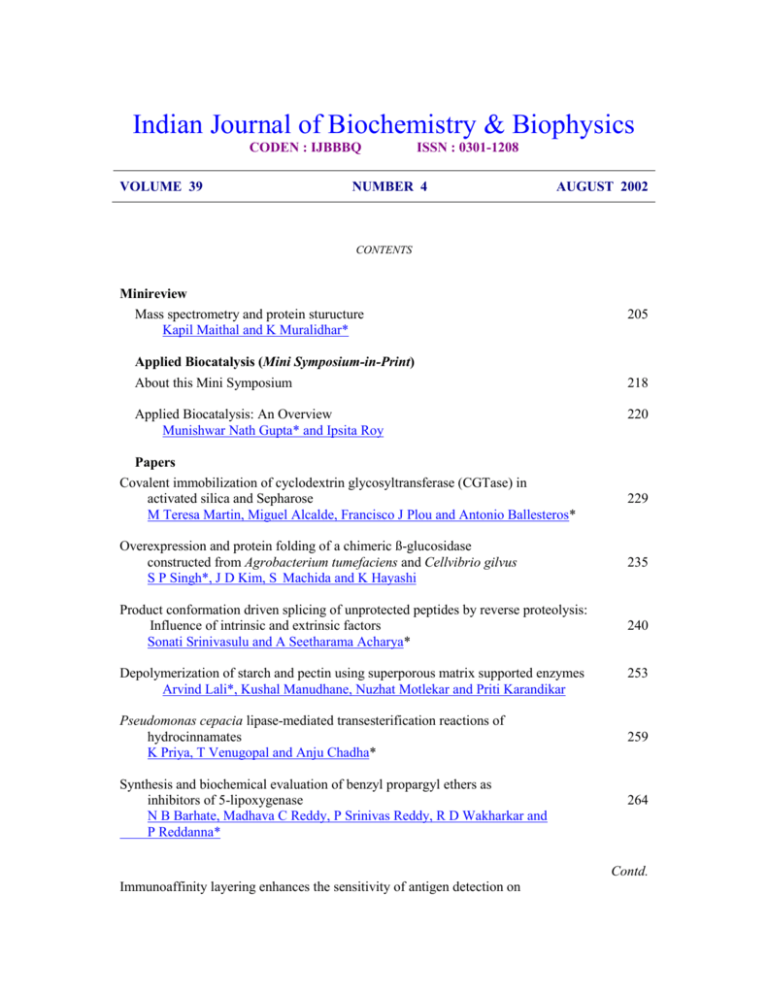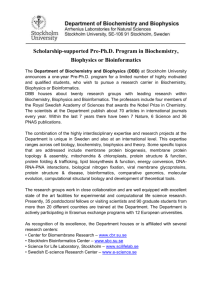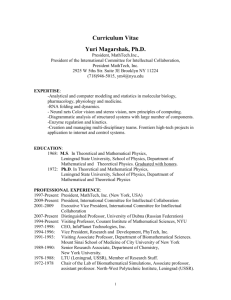web-aug02
advertisement

Indian Journal of Biochemistry & Biophysics CODEN : IJBBBQ VOLUME 39 ISSN : 0301-1208 NUMBER 4 AUGUST 2002 CONTENTS Minireview Mass spectrometry and protein sturucture Kapil Maithal and K Muralidhar* Applied Biocatalysis (Mini Symposium-in-Print) About this Mini Symposium Applied Biocatalysis: An Overview Munishwar Nath Gupta* and Ipsita Roy Papers Covalent immobilization of cyclodextrin glycosyltransferase (CGTase) in activated silica and Sepharose M Teresa Martin, Miguel Alcalde, Francisco J Plou and Antonio Ballesteros* 205 218 220 229 Overexpression and protein folding of a chimeric ß-glucosidase constructed from Agrobacterium tumefaciens and Cellvibrio gilvus S P Singh*, J D Kim, S Machida and K Hayashi 235 Product conformation driven splicing of unprotected peptides by reverse proteolysis: Influence of intrinsic and extrinsic factors Sonati Srinivasulu and A Seetharama Acharya* 240 Depolymerization of starch and pectin using superporous matrix supported enzymes Arvind Lali*, Kushal Manudhane, Nuzhat Motlekar and Priti Karandikar Pseudomonas cepacia lipase-mediated transesterification reactions of hydrocinnamates K Priya, T Venugopal and Anju Chadha* Synthesis and biochemical evaluation of benzyl propargyl ethers as inhibitors of 5-lipoxygenase N B Barhate, Madhava C Reddy, P Srinivas Reddy, R D Wakharkar and P Reddanna* 253 259 264 Contd. Immunoaffinity layering enhances the sensitivity of antigen detection on nitrocellulose strips Hina Jamil and Mohammed Saleemuddin* 274 Resolution of a complex ionic mixture of an apparently homogenous protein preparation by preparative electrophoresis Ashok K Dubey 279 Indian Journal of Biochemistry & Biophysics Vol. 39, August 2002, pp.205-216 Mass spectrometry and protein structure Mini review Kapil Maithal1 and K Muralidhar2* Received 24 April 2002; accepted 6 June 2002 Indian Journal of Biochemistry & Biophysics Vol. 39, August 2002, pp.220-228 Applied Biocatalysis: An Overview Munishwar N Gupta* & Ipsita Roy Received 12 July 2002 Indian Journal of Biochemistry & Biophysics Vol. 39, August 2002, pp.229-234 Covalent immobilization of cyclodextrin glucosyltransferase (CGTase) in activated silica and Sepharose M Teresa Martín, Miguel Alcalde, Francisco J Plou and Antonio Ballesteros* Received 14 June 2002; accepted 19 June 2002 Cyclodextrin glucanotransferase is a non-Leloir glycosyltransferase that directly employs the free energy of cleavage of starch to produce cyclodextrins. In presence of appropriate acceptors, this enzyme synthesizes oligosaccharides containing (14) bonds. We have investigated the covalent immobilization of CGTase onto different activated supports. Silica was aminated and further activated with glutaraldehyde. The maximum amount of bound protein was about 4 mg CGTase per gram of support; however, the catalytic efficiency of the immobilized enzyme was lower than 6%. Sepharose 4B activated with cyanogen bromide (CNBr-activated Sepharose) and Sepharose 4B with a spacer arm of 1,6diaminohexane (EAH Sepharose) were also assayed. These gels react with the amino and carboxylic groups of CGTase, respectively. With CNBr-activated Sepharose, a low percentage of enzyme was bound to the support but with a significant catalytic efficiency (29%). A higher recovery of protein was obtained with EAH Sepharose (62%), but only 2.4% of the initial activity was present in the immobilized biocatalyst. The results were discussed in terms of CGTase structure and mechanism. In addition, the solvent accessibility of amino or carboxylic groups, calculated using the NACCESS software, was considered. Indian Journal of Biochemistry & Biophysics Vol. 39, August 2002, pp.235-239 Overexpression and protein folding of a chimeric glucosidase constructed from Agrobacterium tumefaciens and Cellvibrio gilvus S P Singh*2, J D Kim@1, S Machida1 and K Hayashi1 Received 28 April 2002; revised and accepted 9 June 2002 In continuation of our investigation on structure and function relationship of -glucosidases from mesophilic and thermophilic bacteria, we constructed a chimeric gene by shuffling 17% length in C terminal region of ß-glucosidase of Agrobacterium tumefaciens with the corresponding homologous region of Cellvibrio gilvus -glucosidase. The chimeric gene was overexpressed in E. coli BL21 (DE3) using pET vector. However, nearly all of the -glucosidase produced was trapped into inclusion bodies in catalytically non-functional state. Attempts were made to solubilize the overexpressed protein by coexpression with molecular chaperone, GroEL/ES, in vivo. The molecular chaperone assisted protein folding that had earlier yielded encouraging results, did not improve the solubilization in the present case with a chimeric -glucosidase. Further, we explored protein renaturation under in vitro conditions using various dialysis strategies. Dialysis, rapid dilution and a newly devised method of folding immobilized proteins yielded active enzyme. The usefulness of the in vitro folding methods to obtain functional enzymes from overproduced but non-functional proteins has been discussed. Indian Journal of Biochemistry & Biophysics Vol. 39, August 2002, pp.240-252 Product conformation driven splicing of unprotected peptides by reverse proteolysis: Influence of intrinsic and extrinsic factors Sonati Srinivasulu1 and A Seetharama Acharya1,2 * Received 11 June 2002; revised and accepted 5 July 2002 The structural motif of ‘product conformation driven V8 protease catalyzed ligation reaction’ can be represented by FRI-EALER-FRII. The relative roles of the flanking regions (FRI and FRII) and of splicedon, the central penta-peptide, on the thermodynamic stability of the ‘conformational trap’ of the product has been now evaluated as a function of co-solvent concentration. The studies have established that the thermodynamic stability of the conformational trap of 17-40des23-26 with four different splicedons (EALER, EALEV, EYGER, or EGAER) that differ in the intrinsic -helical potential of their amino acid residues and/or ability to generate i, i+4 side chain interaction is a direct correlate of the n-propanol induced -helical conformation of the product. On the other hand, when the product is defined by only splicedon EALER, and the flanking regions are disitinct; no correlation could be drawn between the stability of the trap and solvent induced - helical conformation, even though these generally give an equilibrium yield of 45% in 30% n-propanol and is not influenced by an increased propanol concentration. However, when the splicedon EALER with given FRI and FRII region develops a ‘conformational trap’ of a lower stability in 30% propanol as seen with 18-25(A22)-EALER-31-39, the stability increases in 60% n- propanol, without significant increase in the - helical conformation. Though, primary structure of RNAse1-20, could be presented as RNAse1-5-AKFER- RNAse11–20, and -helical conformation is induced to this peptide both in 30 and 60% propanol, splicedon AKFER by itself does not develop the ‘conformational trap’ of RNAse1-20. The splicedon AKFER of RNAse1- 20 fails to develop the ‘conformational trap’, due to an intrinsic inhibitory potential of its FR II region, RNAse11-20; replacing RNAse11-20 with 32-40 enables the splicedon AFKER to generate the ‘conformational trap’. The studies presented here have demonstrated the primary role of flanking regions in establishing the amount of the solvent induced -helical conformation and that of the splicedon in dictating the thermodynamic stability of its ‘conformational trap’ of the products, nonetheless one influences the other to some degree. We suggest that the stability of the ‘conformational trap’ of the product reflects the ability of the splicedon to ‘recruit’ the product conformation to protect the spliced peptide bond, i.e. to reduce the helix-coil transition of the spliced region which in turn imparts a degree of resistance to the spliced peptide bond. Indian Journal of Biochemistry & Biophysics Vol. 39, August 2002, pp.235-258 Depolymerization of starch and pectin using superporous matrix supported enzymes Arvind Lali*, Kushal Manudhane, Nuzhat Motlekar and Priti Karandikar Received 23 June 2002; revised and accepted 28 June 2002 Immobilized enzyme catalyzed biotransformations involving macromolecular substrates and/or products are greatly retarded due to slow diffusion of large substrate molecules in and out of the typical enzyme supports. Slow diffusion of macromolecules into the matrix pores can be speeded up by use of macroporous supports as enzyme carriers. Depolymerization reactions of polysaccharides like starch, pectin, and dextran to their respective low molecular weight products are some of the reactions that can benefit from use of such superporous matrices. In the present work, an indigenously prepared rigid crosslinked cellulose matrix (called CELBEADS) has been used as support for immobilizing alpha amylase (1,4--D-glucan glucanohydrolase, EC 3.2.1.1.) and pectinase (endo-PG: poly(1,4--galactouronide) glycanohydrolase, EC 3.2.1.15). The immobilized enzymes were used for starch and pectin hydrolysis respectively, in batch, packed bed and expanded bed modes. The macroporosity of CELBEADS was found to permit through-flow and easy diffusion of substrates pectin and starch to enzyme sites in the porous supports and gave reaction rates comparable to the rates obtained using soluble enzymes. Indian Journal of Biochemistry & Biophysics Vol. 39, August 2002, pp.259-263 Pseudomonas cepacia lipase - mediated transesterification reactions of hydrocinnamates K Priya, T Venugopal and Anju Chadha* Received 10 May 2002; revised and accepted 11 June 2002 Use of lipase from Pseudomonas cepacia in transesterifcation reactions of ethyl hydrocinnamate with different alcohols has been examined. Among the alcohols tested, viz., n-butanol, iso-amyl alcohol, benzyl alcohol, n-octanol and 1-phenylethanol, only n-butanol yielded the transesterified product. Among the solvents tested, viz., n-heptane, n-hexane, cyclohexane, toluene, diisopropylether and n-butanol, the initial rate of transesterification proceeded in the order cyclohexane > n-heptane > n-hexane > diisopropylether > n-butanol > toluene. Using hexane as the solvent and a substrate to enzyme ratio of 1:5, the substrate to alcohol ratio was varied to maximize the yield. n-Butyl hydrocinnamate was obtained in 92% yield in 48 hr by employing a 1:1 (wt/wt) ratio of ethyl hydrocinnamate to lipase and a 1:5 (vol/vol) ratio of ethyl hydrocinnamate to n-butanol in hexane. Indian Journal of Biochemistry & Biophysics Vol. 39, August 2002, pp.264-273 Synthesis and biochemical evaluation of benzyl propargyl ethers as inhibitors of 5-lipoxygenase N B Barhatea, Madhava C Reddy, P Srinivas Reddy, R D Wakharkar a and P Reddanna* Received 18 May 2002; revised and accepted 18 June 2002 A series of benzyl propargyl ethers were synthesized and tested as inhibitors of 5-lipoxygenase, the key enzyme involved in leukotriene biosynthesis. Among these, optimum activity was displayed by 1-(2heptynyloxymethyl) benzene 12 (IC50 1.2 M). Addition of carboxyl group at the end of the alkyl side chain attached to the acetylenic group abolished the inhibition. Selective reduction of the acetylenic group to cis or trans double bond reduced the inhibitory potential, the cis isomer 24 showing more than 20-fold higher inhibition than the trans isomer 25. Introduction of sulphur in place of oxygen in the alkyl side chain attached to the (carboxyalkyl) benzyl group also reduced the inhibition. The IC 50 value of 12, towards rabbit reticulocyte 15-LOX is > 50 fold higher than that of 5-LOX. These results indicate that compound 12 is a specific inhibitor of 5-LOX. Indian Journal of Biochemistry & Biophysics Vol. 39, August 2002, pp.274-278 Immunoaffinity layering enhances the sensitivity of antigen detection on nitrocellulose strips Hina Jamil1 and Mohammed Saleemuddin*1, 2 Received 17 April 2002; revised and accepted 17 June 2002 A simple strategy to remarkably increase the sensitivity of detection of antigens applied as dot or western blot on nitrocellulose membrane using human serum albumin as model antigen has been described. This involves subjecting the antigen bearing nitrocellulose strips to multiple incubation cycles with primary antibody and enzyme conjugated secondary antibody prior to staining for enzyme activity. The sensitivity of detection could be increased up to a thousand fold after three incubation cycles. Aggregation of human serum albumin could be detected by the multiple incubation procedure at very low protein concentration after electrophoresis and transfer onto nitrocellulose. Indian Journal of Biochemistry & Biophysics Vol. 39, August 2002, pp.279-283 Resolution of a complex ionic mixture of an apparently homogenous protein preparation by preparative electrophoresis Ashok K Dubey* Received 3 May 2002; revised and accepted 30 May 2002 Preparations of recombinant envelope glycoprotein E2 of hepatitis C virus (r-HCV E2), found to be homogeneous by N-terminal amino acid sequencing and mass spectrometry, resolved into multiple ionic species (isoforms) when analysed by isoelectric focusing (IEF) gel electrophoresis in the pI range of 3-10. These isoforms possessed pI values in the range of 4.5-8.2. The major isoform with pI value of approximately 7.1 was separated from the rest of them by employing a method developed on Gradiflow BF 200, a device based on preparative electrophoresis. This isoform was adjudged to be homogenous by IEF and by native polyacrylamide gel electrophoresis (PAGE).









